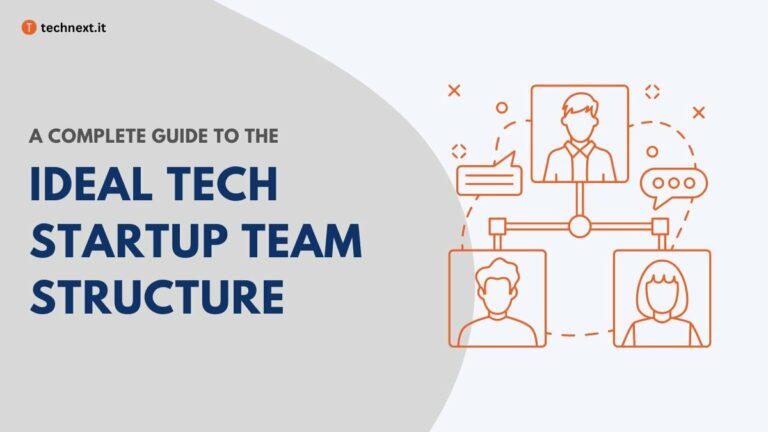Guide to Ideal Project Management Organizational Structure
Explore crucial aspects of project management organizational structures and create a winning team for your project.

When starting a project, your ultimate goal is success. As a skilled leader, you know who to involve and what steps to take. However, achieving success in project management often requires more than competent team members and thorough preparation.
You need the full contribution of each of your team members. Only clearly defined roles and responsibilities and a well-defined organizational structure can guarantee such a level of commitment.
Without a proper project management organizational structure, your team members can get caught up in chaos, causing delays and even failures.
In this article, I will cover the basics and advanced aspects of this topic to help you create the perfect organizational structure for your project.
Understanding the Basics
What is project management organizational structure?
Project management organizational structure refers to how you organize the roles and responsibilities of the employees involved in your project. It specifies decision-making authority, reporting relationships, and workload allocation of your project.
Let me simplify it with an example: Assume you have a software firm, and for every project, you have different types of employees with different roles and responsibilities in different teams. To execute your projects successfully, you have to figure out how to establish the reporting structure of a project and its associated hierarchy.
This is where your project management organizational structure comes to the rescue. It defines the decision-makers, who answers to whom, and, more importantly, how each team member contributes to the overall effort around a project.
Why a good organizational structure is crucial to project success?
Want to ensure the success of your project? Set up your project team well, and you’re halfway there. Yes, that’s how important it is. Ask any project manager, and you will know that team structure is just as important as team members. This is how a good organizational structure can contribute to the success of your project.
Establishing clarity: Outlines each team member’s duties and accountability so everyone understands what to do. This lowers team confusion, redundancy, and conflict.
Streamlining communication: It facilitates teamwork and stakeholder communication. Effective communication contributes to resolving issues, update sharing, and decision-making.
Effective resource allocation: It helps allocate and manage resources (like time, budget, employees, equipment, etc.) to plan, execute, monitor, and regulate activities so that you can avoid delays and overruns.
Enhanced Coordination: Clarifying roles improves team, department, and stakeholder cooperation in achieving goals. It also guarantees to provide high-quality outputs that fulfill deadlines.
Innovation and changes: Changes in criteria, scope, and market situations are common throughout projects. Flexible organizational structures make these transitions easier.
Identifying skill‑shortage areas: Different project types may need unique skills and knowledge. It identifies the areas and assigns resources with specific skills in those areas.
Managing risks: Integration of risk assessments, mitigation techniques, and backup strategies into project management, etc., reduces the risk. This also helps identify and prepare for any possible issues.
5 Types of Organizational Structures in Project Management
You probably know by now that a well-structured project management organization is essential to your project’s success. Every step of your project will be influenced by the structure you choose. So, you must understand different organizational Structures before choosing one.
There are several organizational structures for project management, depending on the organization’s mission, objectives, and the nature of the work being done, and each structure has its own set of pros and cons. Here, I will discuss the five types of organizational structure in project management.

1. Functional organization structure
The functional structure is often considered one of the most frequently used team structures in the current world. In this structure, your employees are grouped according to their area of expertise. A functional manager is responsible for the success of the project; Therefore, he must be an expert in the field.
So, what about the project manager? Most organizations with this kind of structure don’t have project managers, and if they do, the job of the project manager will be very limited.
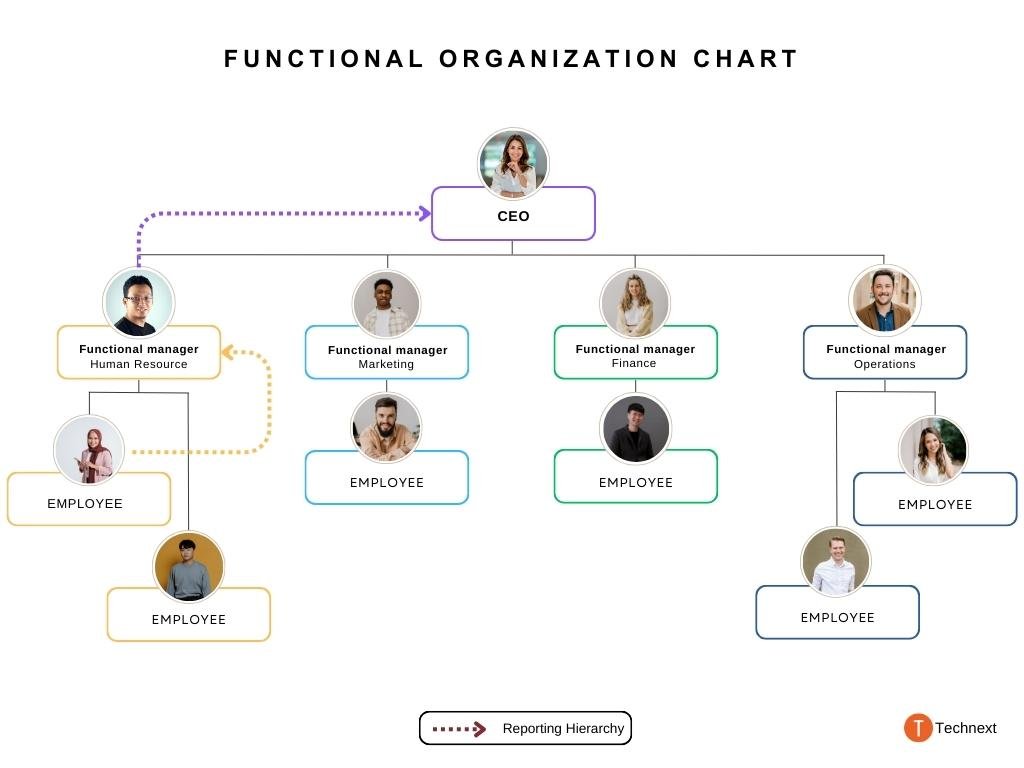
The functional organizations are usually subdivided into departments such as human resources, marketing, finance, and operations. Each employee reports directly to one supervisor, and each department operates independently. As a result, the work in this structure is well specified.
The primary benefit of a functional organizational structure is that it is a stable structure in which each team member focuses on their core activities and develops their departmental knowledge.
Unit coordination is the main weakness of this functional structure. Since each department has its own goals and priorities, it can be hard for teams to communicate with each other and work together as a unit.
2. Projectized organization structure
The projected organization is the opposite of a functional organization. The focus of this type of organization is the project itself. The key idea is to build your employees’ loyalty towards the project, not the functional manager.
In this structure, the power and authority belong to your project manager – one per project. Everyone else in the team reports to the corresponding project manager. Team members are often collocated. They also provide support services to other projects.
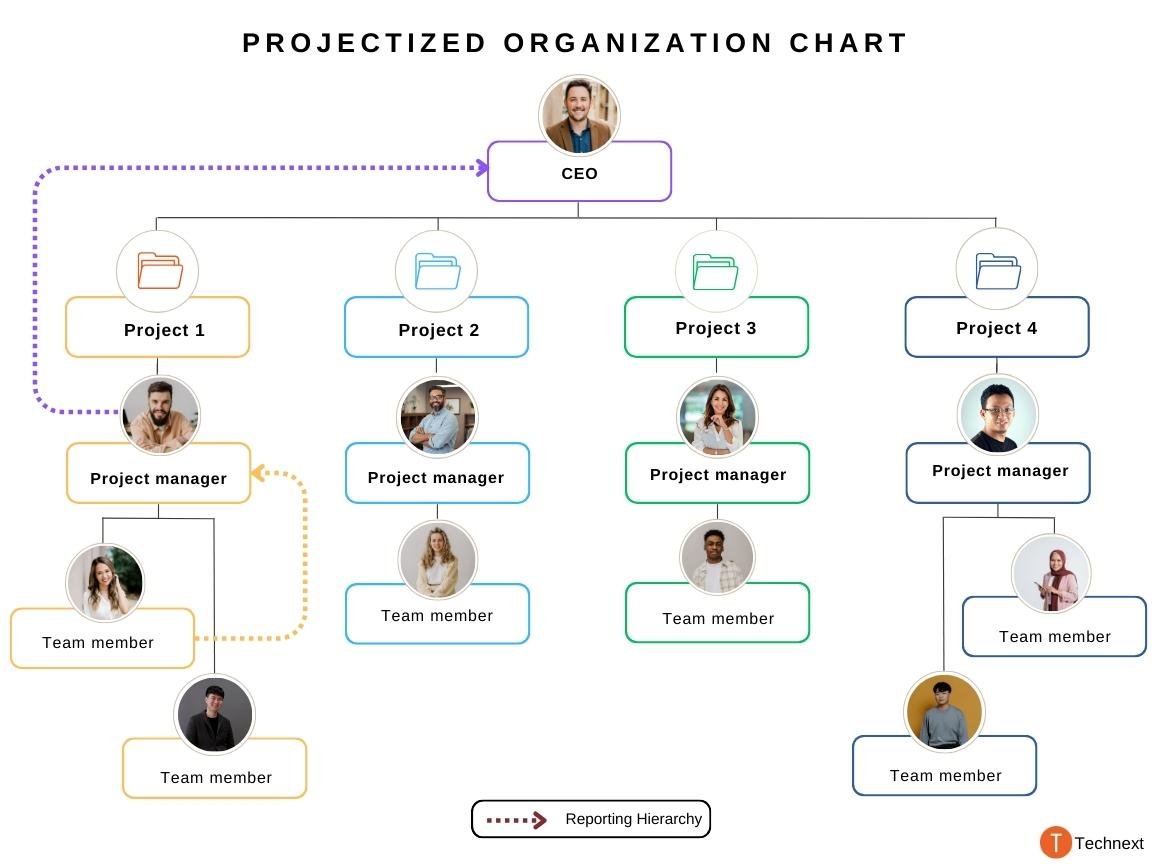
The good thing about this type of structure is the clear and established line of authority, which results in faster decision-making. As resources are typically allocated on a project-by-project basis, duplication of resources is one of the biggest drawbacks of a Projectized Organization Structure.
3. Matrix organizational structure
The next one is one of the most adaptable project management structures: the Matrix Organization Structure. Matrix org structure is a combination of Functional and Projectized Organizational Structures.
Project team members in a Matrix Organization have two distinct reporting lines. One is your functional manager, and the other is your project manager. Depending on the type (weak, balanced, or strong ) of matrix organizational structure, the responsibility of your functional manager and project manager varies.
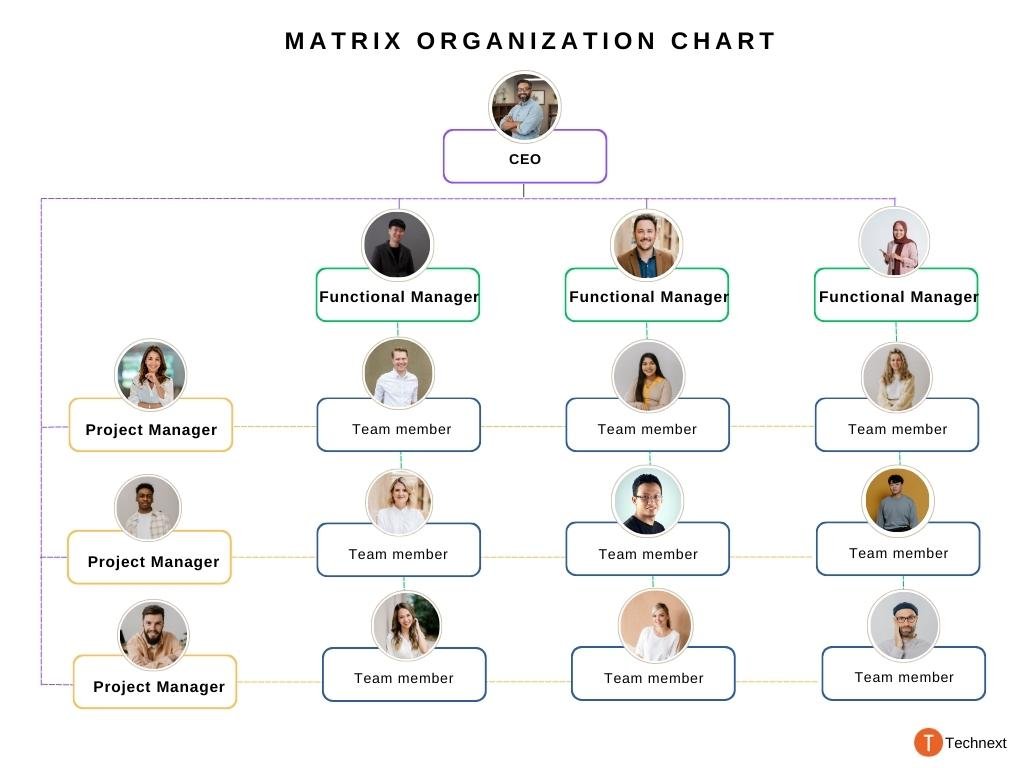
The most significant benefit is it encourages collaboration and increases communication. The most obvious drawback that comes with this benefit is potential conflicts between the heads, which can create confusion among the employees.
4. Composite organization structure
The fourth type of organization structure is Composite Organization Structure, a combination of all three (Functional, Projectized, Matrix ) structures. Nowadays, almost all modern companies use the composite organization structure.
Let’s assume you are managing different projects. For some, you are following a Functional Organization Structure, and for others, a Balanced Matrix Organization Structure.
Now, there is a new project where it is beneficial for the team to follow the Projectized Organization Structure. So, you started using that one for the specific project. This is what a Composite Organization Structure is like.
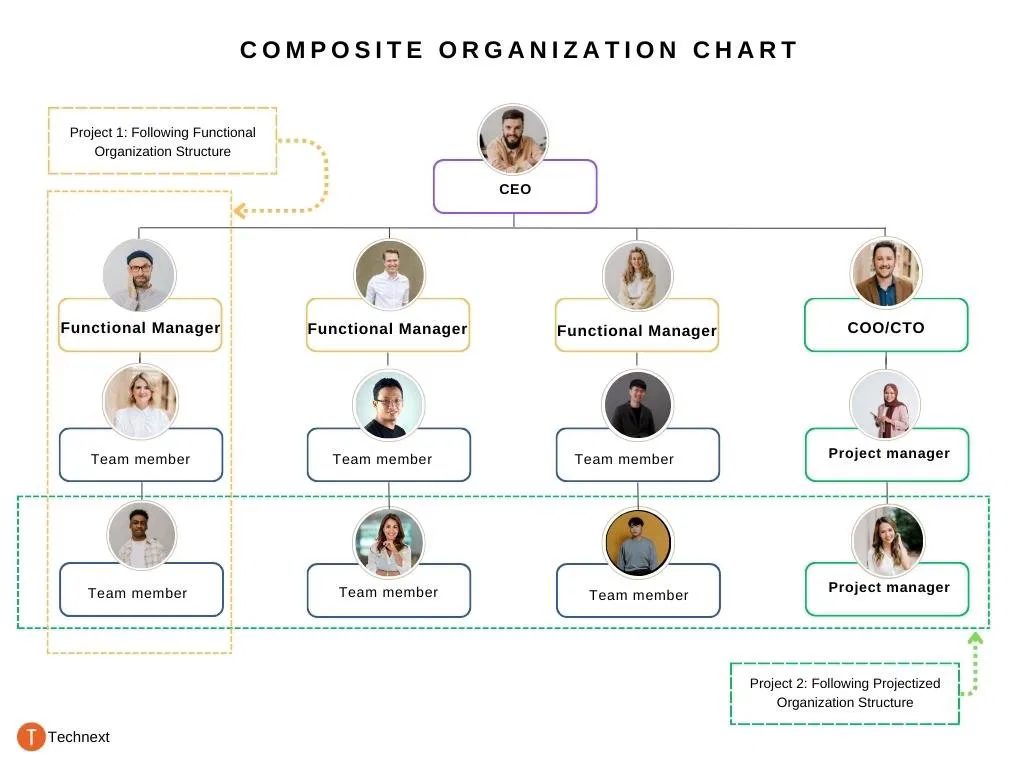
In a composite structure, you may benefit from the advantages of different structures, such as specialization, efficiency, customer focus, flexibility, etc. However, you can also face challenges like complexity, confusion, conflict, cost, etc.
5. Flat organization structure
This one is very popular with startups and small businesses. The reason is flat organizational structure has no or little middle management between the employees and the higher-level executives.
Employees have direct access to the company leaders. They report directly to them. As for the responsibilities of middle managers, the team and the executives shared them.

Due to this short chain of command, the team is highly independent and makes most decisions. Without a hierarchical system, the team has faster communication, collaboration, and less salary to pay.
But when your startup starts growing, this structure has poor scalability. Also, it becomes tough to understand who is responsible for what activity, which creates confusion around reporting systems.
How to Choose an Effective Project Management Organizational Structure
Well, It’s time to find an organizational structure that suits your company’s goals, culture, and industry. Here’s a step-by-step suggestion for you on how you can choose an effective Project management organizational structure.
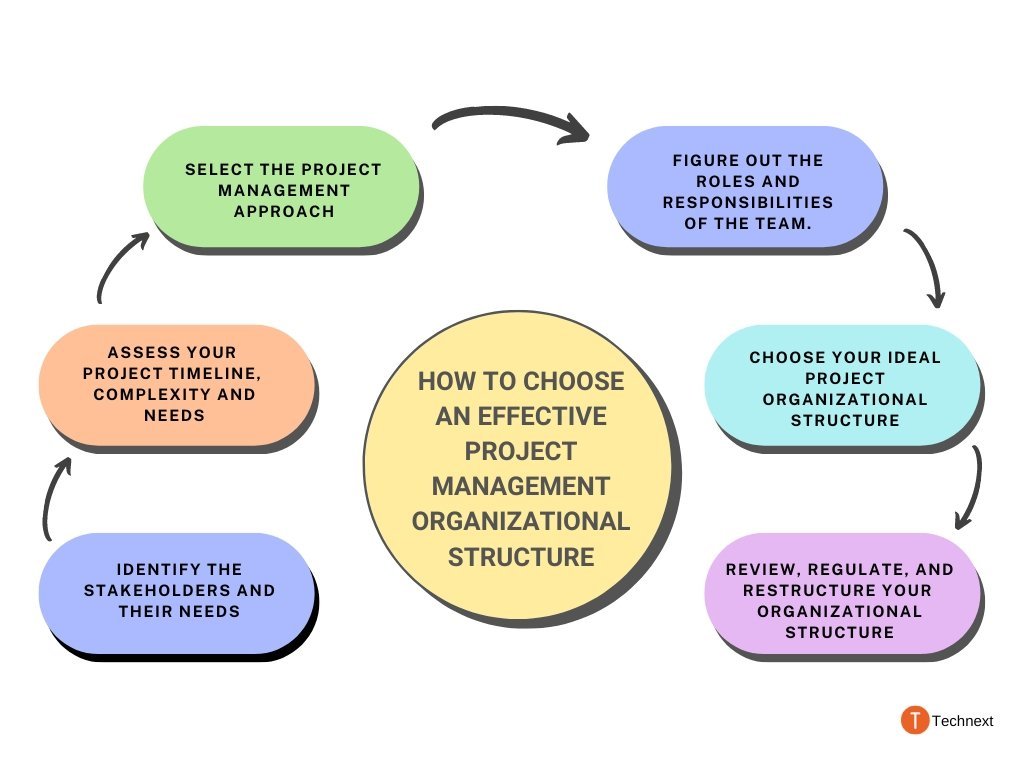
Step 1: Identify the stakeholders and their needs
The first step you need to take is to identify your stakeholders and their needs. Your stakeholders are the individuals involved in the project, including your clients, sponsors, team members, and other relevant parties. You can start by making a complete list of all your stakeholders.
Then, prioritize the stakeholders based on their power, interest, and influence in your project. You can use tools like stakeholder maps, matrices, or charts to visualize and categorize the stakeholders.
Once you’ve identified the stakeholders, dive deeper to understand their specific interests, expectations, and priorities related to the project. You can conduct interviews, surveys, or meetings to gather this type of information.
Step 2: Assess your project timeline, complexity, and needs
After the first step, you have a strong base for moving to the second step, assessing your project.
To assess your project, first, clearly define the goals and objectives of your project. You can use a project charter and Work breakdown structure (WBS) to define the project’s goals and objectives.
With the project goals, you also need to analyze the complexity of your project. If your project is complex, you are going to need robust project management structures with detailed reporting and control mechanisms.
You also need to understand the timeline of your project to select the organizational structure. To assess the timeline of your project, you can split the project into milestones and then estimate the time of each task.
Step 3: Select the project management approach
The project management approach is the framework that will guide you in planning, executing, monitoring, and controlling your project. You can choose from different types of project management approaches.
- If your project has well-defined goals, a stable scope, traditional, and sequential approach like Waterfall will be suitable for you.
- The Agile approach is for projects with high uncertainty, complexity, change, and flexibility.
- You can consider Scrum if your project is focused on delivering incremental value and requires close team collaboration.
- If your project has elements of both Waterfall and Agile, a hybrid method might be best. You can combine the best practices from different approaches as per your project’s needs.
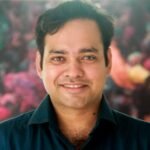
Need help selecting a project management approach?
Consult with our expert project manager for free.
Step 4: Figure out the roles
Once you are done with choosing your project management approach, it’s time to move on to your team. Your team is an essential part of finding out the effective project management organizational structure.
You can start by reviewing your project charter. Then, identify the skills, knowledge, and experience that are required to perform the project work.
After that, determine the number and type of resources (including personnel, budget, and equipment) that are available and needed for your project. From the resource allocation, you can understand how many people you can hire, the skill level of the individuals, etc.
This way, you can figure out the roles and reporting hierarchies of the project team members. By defining the roles and responsibilities of the project team members, you can ensure that everyone understands their part in the project and how they contribute to its success.
Step 5: Choose your ideal project organizational structure.
By this point, you have gathered a wealth of information about the project, its stakeholders, characteristics, management approach, and team roles. You are going to need all this information while choosing your ideal project organizational structure.
As we mentioned above, there are five types of organizational structures that are commonly used in project management – Functional, Projectized, Matrix, Composite, and Flat.
Now, all you have to do is analyze the information and make a decision based on your project needs.
Say you have a software development project. The ideal project management structure will be highly influenced by the project management approach.
We all know that companies, even startups, manage many more projects than development projects. What will you do in such cases?
Well, there is no one absolute solution, but studies have shown that certain types of projects are managed well with certain structures. Here’s a table describing the optimum structure based on project types.
| Organizational Structure | Description | Suitable Project Management Approaches | Most Common Team Approach |
| Functional Organizational Structure | In this structure, team members are grouped by their functional roles (e.g., marketing, engineering, finance) and report to departmental managers. | – Waterfall – Traditional project management | Marketing, Development |
| Projectized Organizational Structure | In a projected structure, teams are organized around projects, and project managers have full authority over team members. | – Agile (especially Scrum) – Hybrid approaches – Small to medium-sized projects | Design, Development |
| Matrix Organizational Structure | Matrix structures blend elements of both functional and projected structures. Team members have dual reporting relationships with both functional managers and project managers. | – Balanced Matrix: Project managers and functional managers share authority. – Strong Matrix: Project managers have more authority. – Weak Matrix: Functional managers retain more control. – Hybrid approaches | Sales, Development |
| Composite Organizational Structure | This is a flexible structure that adapts to the specific needs of each project. It can incorporate elements of functional, projectized, and matrix structures as required. | – Hybrid approaches – Large, complex projects with varying needs | |
| Flat Organizational Structure | This type of structure has no or little middle management between the employees and the higher-level executives. very popular with startups and small businesses | HR, Development |
In addition to the approach and type of project management, the stage of our organization plays a crucial role in the team structure. So, consider all of these factors and discover the right organizational structure for you.
Step 6: Review, regulate, and restructure
Figuring out the best project management team structure requires continuous iterations. Throughout the project lifecycle, you need to continuously review the progress, monitor resource utilization, and regulate project activities.
Regular reviewing and making adjustments are the key to ensuring that the project stays on course and meets its objectives. If necessary, be prepared to restructure the project organization to address any emerging issues or changes in project requirements.
Examples of Project Management Team Structures
Hopefully, now you know how to choose an effective organizational structure for your organization. Looking at what others have done and getting inspired always helps.
So, in the following portion, I have discussed some examples based on different teams to help you understand more.
As I mentioned before, there is no definitive answer to which organizational structure is better for which team. It depends on factors like team size, project type, control & oversight, skill, and adaptability of your project.
Example 1: Marketing team organizational structure.
Let’s say you want to choose an organizational structure for your marketing team. The most common team approach is the Functional Organizational structure. Where you can divide the team into functions like Brand Marketing, Operations, Content, Product, Growth, etc.
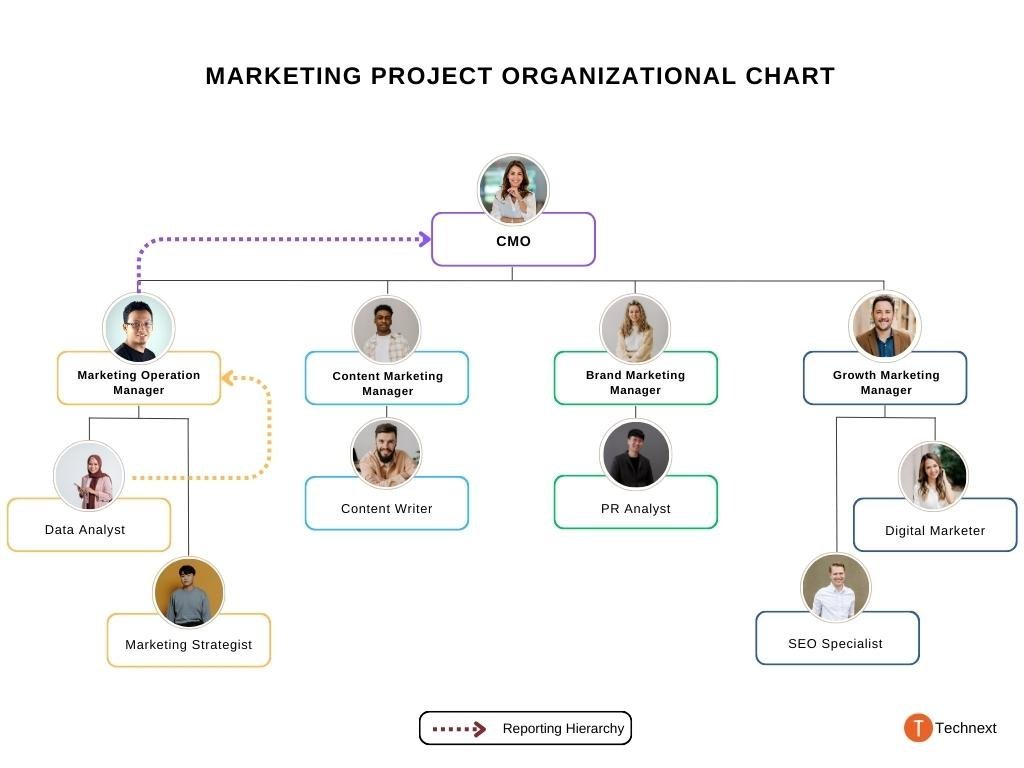
Your dedicated functional managers will manage each function. The other team member will report to the functional manager. And the manager will report to your CMO. If you are a startup founder, the marketing team structure will vary depending on the stages your startup is in.
Example 2: Development team organizational structure
The next team I want to discuss is the development team. As for the development team, it depends on it depends on your organization’s current phase.
Say your organization is in the startup phase; a Flat organizational structure will be more suitable for you. If it’s in a Mid-level phase, a Projected or Functional organizational structure is better. For your big organization, you can use Matrix organizational structure.
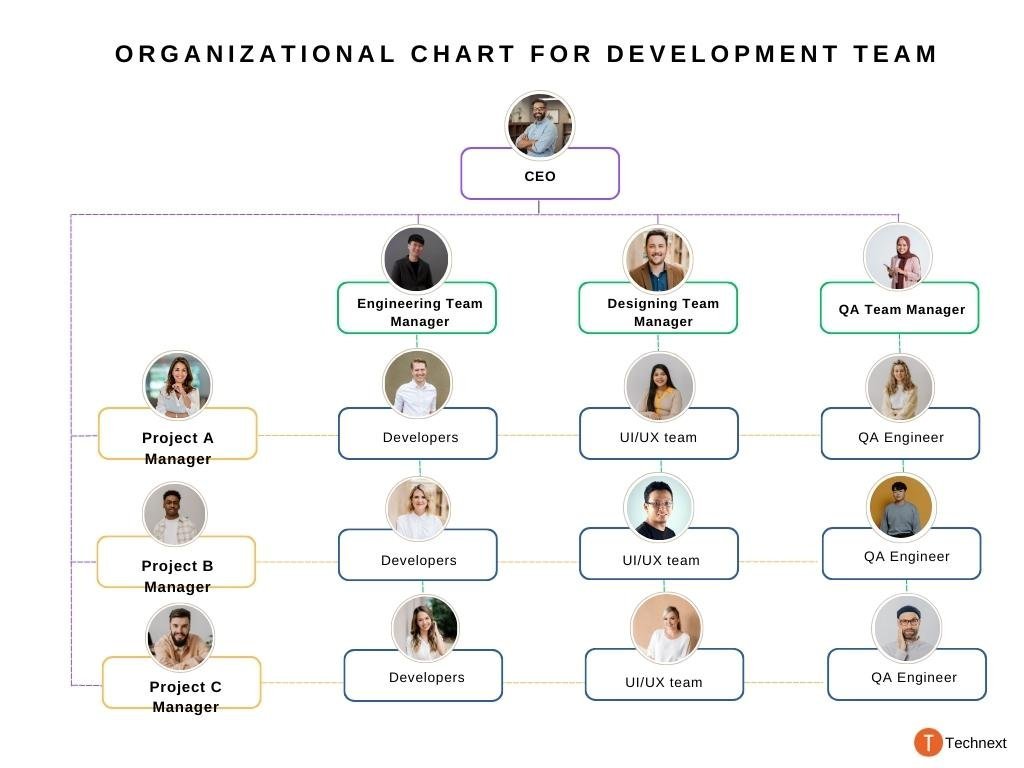
Example 3: Design team organizational structure
A projectized organizational structure would be the best choice for the design team. Where one project belongs to one project manager, other team members report to your manager. And the project managers report to the Head of design.

Common Mistakes to Avoid
The team structure figuring process is time-consuming and complex. So, you will likely make mistakes along the way. Don’t worry; we’ve got you covered. Here is the list of common mistakes you should be aware of –
- Fail to consider the unique characteristics of your project. You will need organizational structures that suit the unique aspects of your project.
- Not involving your team and stakeholders in the decision-making process. They can help you identify the preferences and expectations about the project.
- Not researching enough about the organizational structures. You can also consider hybrid or customized structures that combine elements of different structures to suit your project needs.
- Understating the resources (human resources, budget, and technology) can result in resource shortages that slow project progress. You can use your resources in other projects.
- Lack of clearly defined roles can lead to confusion and conflicts within the project team. Clear role definitions are vital for accountability and teamwork.
- Choosing an overly complex structure can result in unnecessary bureaucracy and inefficiency. Make the structure as simple as possible for better results.
- Assuming the chosen structure will remain effective throughout the project without ongoing review and adjustment. Your projects are dynamic, and the structure should evolve accordingly.






